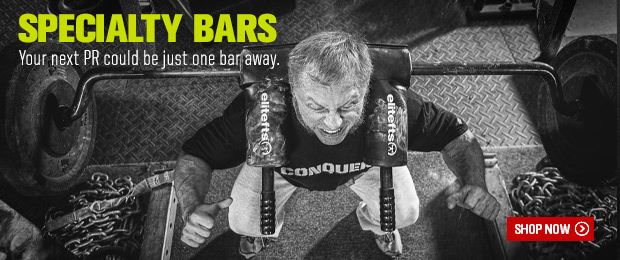
Let’s get the scientific definitions out of the way before heading into the art of the program I am going to unveil for you this month. The famous Australian singer Peter Allen once extolled, “Everything old is new again,” but with a new twist, which maintains its relevance in the 21st century as a training method.
Firstly, the often-used idea of the Pareto Principle that simply states that 80 percent of your results will come from 20 percent of your time. For me, this is a wonderful rational of the “less is more” idea. I also believe that the program that unfurls in this line will be most beneficial to 80 percent of the people who train in gyms around the world. “Apply the 80/20 Principle to Powerlifting” is an excellent reference to the Pareto Principle, and Alexander Cortes does an amazing job in delivering a very sound message.
RECENT: The Art of Programming for Injury Prevention/Risk Management
The second principle I wish to apply to this article is Ocham’s Razor: “All things being equal, the simplest solution tends to be the best one.”
Simplicity, as I have been discussing in numerous articles here at elitefts.com, is the missing ingredient in most training programs. Hence why I return to the famous paradigm of the pull-push-squat, the mainstay of many great lifters and coaches for many decades.
Training variation has always been a key cornerstone of my strength training philosophy, especially when you are dealing with rugby players in particular. Most players will present with an injury or history of injuries that make certain movements almost impossible to perform.
The bars I use on a regular basis in my training programs are cambered bars, trap bars, and safety squat bars.
Rationale 1
Specialty bars allow me to vary the training stimulus around an injury area. Most of the forwards I train have shoulder girdle issues that they find makes holding a bar in a back squat position near impossible, and associated wrist issues that make front squats out of the question.
Enter the cambered bar and safety squat bar into the equation, and the problem is immediately solved. These bars allow the player to position the bar on their bodies in a pain-free area and then squat as per normal. The added advantage is these two bars also provide an increased demand on the erectors of the lower back, which is an area that needs transfer from the gym to the field.
Rationale 2
Specialty bars allow for a variety of stimuli to existing exercise options. In particular would be the cambered bar and trap bar for shoulder pressing movements. The increased range of movement from using the trap bar ensures that the deltoids are effectively trained through a complete range with the elbows starting down around mid-torso, allowing excellent abduction of the humerus in the movement. The cambered bar will move anteriorly and posteriorly, thus increasing the stabilization requirements of the core.
In developing programs, there is a sequence to go through to ensure that you are in the right direction for success to follow from the efforts you put in.
Firstly, what is the priority of your training strength, power, or size? These will impact on the methodology you employ to get results.
WATCH: C.J. Murphy's Specialty Bar Car Show #3
Next, develop an exercise classification chart of all the available movements that you can do in the weight room that you are currently working out in, using the main classifications of pulling movements, pushing movements, and squatting movements. This will greatly assist in controlling the exercises that you use in the horizontal variation of your weekly plan. The next step is determining which style of periodization you believe in which will determine your approach to the vertical progressions you use over time.
The virtues of the three day per week with three exercises each session are that you have both variety of stimulus on the adaptive processes of the body as well as sufficient volume over the course of the week to elicit gains in the area that you have prioritized. I am going to outline a basic three-week template for you.
The exercises selected will be maintained for the entire three weeks of the program, and at the end of this block, a new selection of exercises will be introduced. These may be completely different movements within the basic categories or may be existing exercises but with changing the angles, the type of bar, or even using machines instead of barbells for a block. Those decisions are based around the equipment that you can train on and what is the overall goal of your training plan.
The sets and reps plan I am using for this block is very basic, with straight sets using a plateau load and having a different loading pattern for each exercise and rotating this through the week plan (horizontal variation). The main exercise for each category is performed first in each workout, then the third choice exercise next, and finally finishing the workout with the secondary choice movement.
Week 1

Week 2

Week 3

As mentioned earlier in this piece, the next three-week block will have a different look determined by you in relation to your needs. You can also finish the workout on each day with a Loaded Carry and/or a core movement of your choice, or a metabolic finisher, depending on what your training goal is, and of course, your personal preference.
Your next three-week block may use the Rule of 24 methods across each exercise choice. The Rule of 24 is any combination of sets x reps where the total volume for the exercise equals 24. So for example: 2 x 12, 3 x 8, and 4 x 6 more hypertrophy-related; 5 x 5 (near enough), 6 x 4, 8 x 3, and 12 x 2 more strength- and/or power-focused.
Another excellent method is a certain number of reps with a given Repetition Maximum (RM) loading. For example, 30 reps at 6RM, 40 reps at 8RM, or 50 reps at 10RM, all done in as few sets as possible but ensuring you are working to near failure on each set with a determined rest period between each set.
Feel free to use whichever methods you are most familiar with, but push for the maximum loads you can use with excellent technique and stay the course for each block. Please be patient and avoid Program Promiscuity, where you jump from program to program and are never satisfied with the results you get. Be monogamous and reap the rewards of hard work on basic movements to reach your goals of size and strength.
Next Block
Week 1

Week 2

Week 3

I am always playing with angles in training programs to ensure that a muscle is worked in as many positions as possible and to ensure all movements in the plane of both pushing and pulling are explored fully.
I will also change the grip on the bar from supinated to neutral or hammer to pronated over the course of a session, often attempting to include variations on each exercise to provide an adequate stimulus to the movements and/or areas. For example, upper body pulling:
- Horizontal, let us call that 0 degrees for the purpose of this article, will be worked initially with a pronated grip using a Pendlay or Bent-Over Row movement;
- Next, 45 degrees using the Yates Row with a supinated grip, body inclined 45 degrees from the horizontal;
- And finally, vertical, as there’s no better movement than using the trap bar for shrugs to complete the workout.
And upper body pushing:
- Horizontal Football Bar Bench Press;
- Next, 45-degree Incline Bench Press
As you can see, your programs are limitless variations on the major themes and are only restricted by the types of bars and equipment you have access to in the weight room and your inventiveness in the programming of sets, reps, and loads.











The training block with so many unorthodox excercises and difficult bars is simply stupid.
Stick to basics man.
Why do you suggest building the program around push/pull/squat rather than push/pull/hinge/squat (and possibly loaded carry)?
Wednesday
Movement Prep:
Lunge Sequence – Forward Lunge, Backward Lunge, Lateral Lunge
Overhead Squat
Partner Wheelbarrow walk out & back
Band Face Pulls with External Rotation
Strength as a Peripheral Heart Action (PHA) circuit
Squat option
Hinge option
Upper Body Push option
Upper Body Pull option
Loaded Carry option
Squat Hinge UB Push UB Pull Carry
Box Squat Deadlift Bench Press Bench Row Waiter
Back Squat Trap Bar Incline Bench Pulldown Suitcase
Safety Bar RDL Hammer Press Chin ups Farmer’s
Cambered Bar Hip Thrust Military Press Pendlay Row Zercher
Bulgarian Good Morning Floor Press Yates Row KB Rack
CARE program:
Lateral Planks with Leg Abduction
Lying External & Internal rotation
Hamstring Isometric holds
Banded neck lookaways
STRETCH!
Hope it helps out and hope you keep the young ones terrified for a few more years at least, cheers, ashley